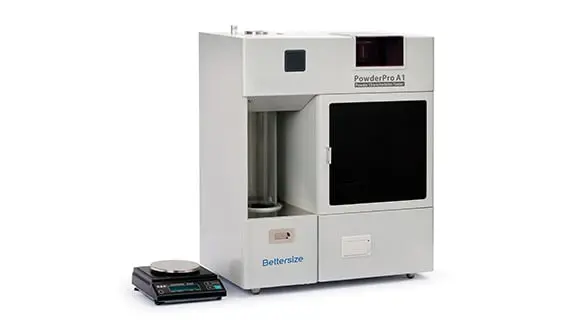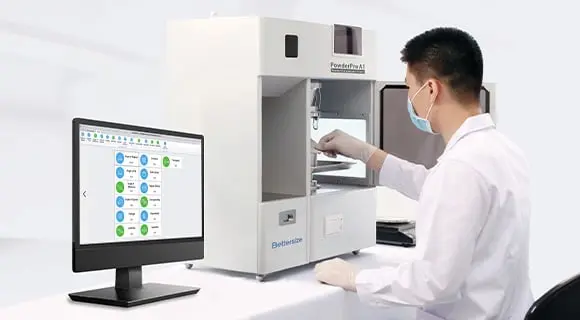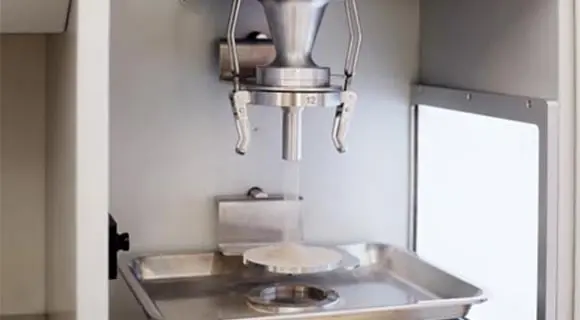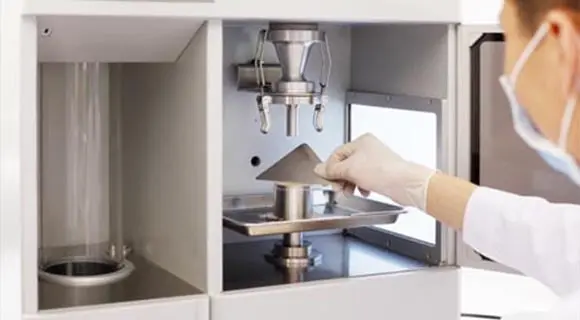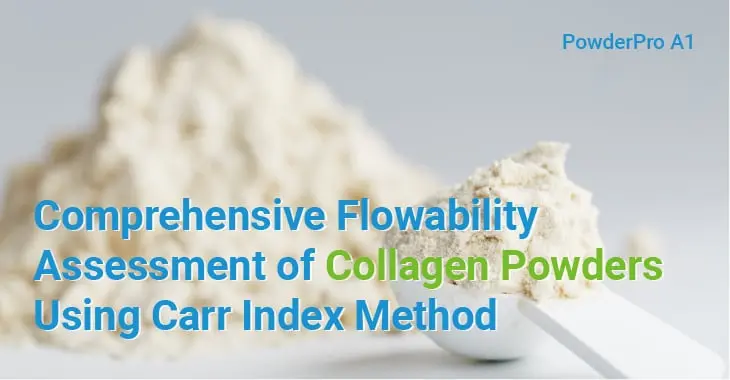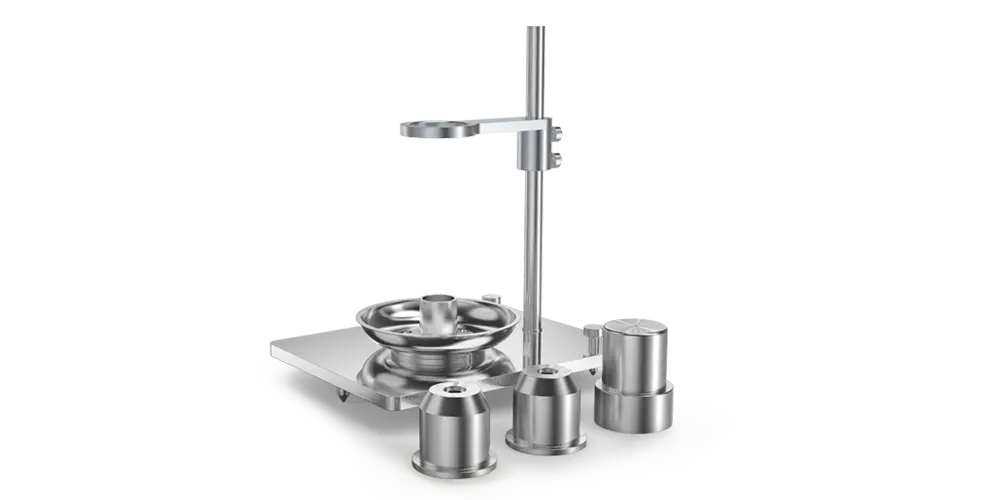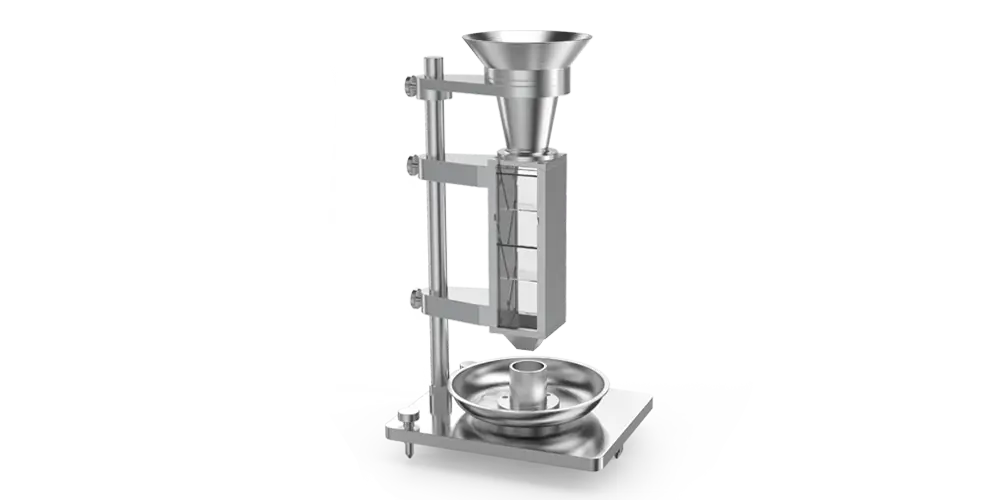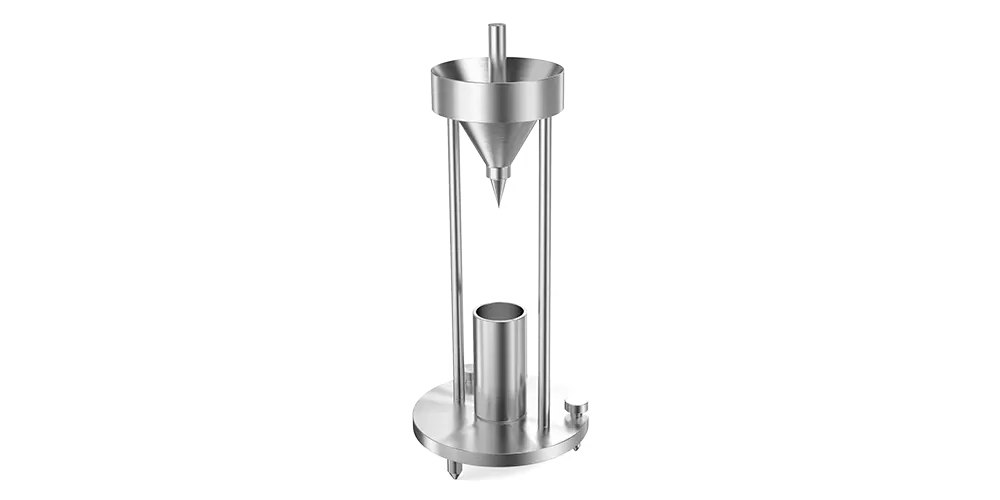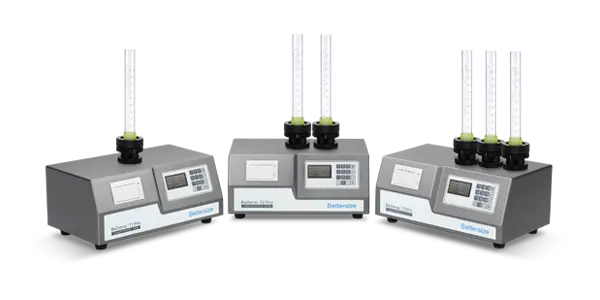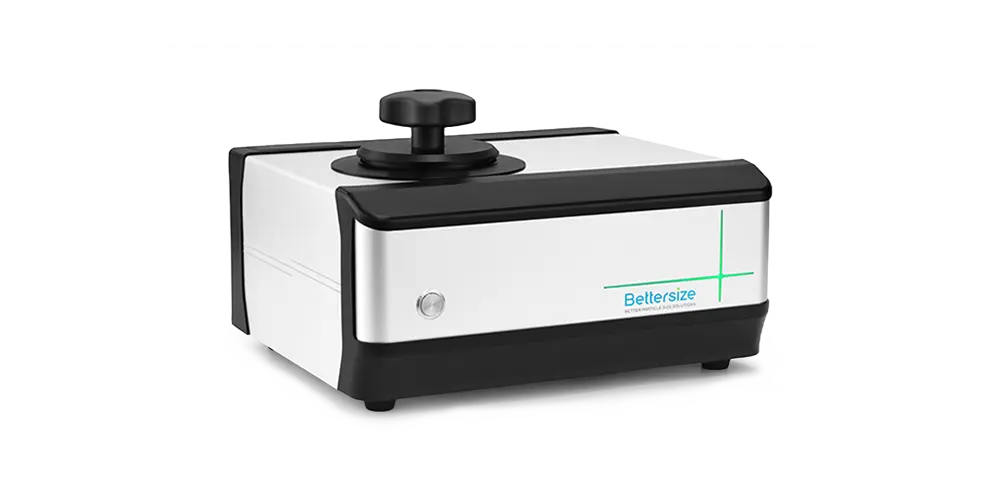PowderPro A1
The PowderPro A1 integrates many state-of-the-art technologies such as intelligent control via Wi-Fi , image processing technology, sieve analysis and 3D electromagnetic vibration technology. It can measure and calculate 14 physical properties of powders in a fast, simple, and accurate way. As an intelligent powder characteristics tester, it is an essential instrument to help you understand and research powder materials.
Features and Benefits
- ● Compact design
- ● Sieve analysis
- ● Convenient data output
- ● Intelligent data transmission
- ● Automated control technology
- ● Automated imaging technology
Video
Spotlight on PowderPro A1 
What is angle of repose? Why and how do we measure it? 
Flowability Calculation of Powder Materials Using PowderPro A1 
Cohesion & Uniformity Measurement and Calculation of Powder Materials Using PowderPro A1 
Tapped Density and Compressibility Measurement of Powder Materials Using PowderPro A1 
Bulk Density Testing of Non-metallic Powder Materials with PowderPro A1 
Angle of Spatula Measurement of Powder Materials with PowderPro A1 
Angle of Repose, Angle of Fall & Angle of Difference Testing of Powder Materials with PowderPro A1 
PowderPro A1 Overview | Automatic Powder Characteristics Tester 
Overview
Citations
- PowderPro A1
Optimization of inorganic powder properties for manufacturing ceramic filter using binder jetting process
DOI: 10.1016/j.addma.2023.103564 Read ArticleKorea University | 2023Porous ceramics are employed in an extensive range of industrial applications due to superior thermal insulation and physical properties that permit their use for separation and storage. However, in conventional manufacturing environments, an additional process is required for artificial pore control. Furthermore, these methods are inferior in terms of the geometric design of the fabricated products owing to limitations in the forming process. To improve these disadvantages, many studies have recently been conducted on the porous structures using additive manufacturing techniques. In particular, binder jetting method can be utilized for fabricating porous ceramics to overcome the limitations of conventional manufacturing process. This study demonstrates an optimal process for the fabrication of porous ceramics by applying binder jetting technology. Powder flowability and compatibility were optimized using the flow agent and the secondary binder. The effects of adding glass frit and adjusting the sintering temperature on the microstructure, porosity, and mechanical properties of the final product were also investigated in detail. Additionally, various filter design of inner flow path was investigated using computational fluid dynamics to improve the filtering efficiency and fabricated using the optimized ceramic powder through binder jetting technique. - PowderPro A1
Hierarchically porous alumina ceramic catalyst carrier prepared by powder bed fusion
DOI: 10.1016/j.jeurceramsoc.2020.03.059 Read ArticleXi'an Jiaotong University | 2020Hierarchical porous ceramic catalyst carriers, which exhibit good catalytic performance, are widely used in the petrochemical industry. However, the fabrication of ceramic carriers with hierarchically porous structures is highly challenging for conventional preparation processes. Thus, a strategy for designing and manufacturing hierarchically porous alumina ceramic catalyst carriers using aluminium trihydrate as raw material and powder bed fusion (PBF) as the forming process is proposed herein. PBF process parameters were optimised to define the processing window for creating ceramics with complex structures. Controllable pore characteristics in nano- and microscales has been achieved by combining dehydroxylation, PBF, and post-sintering processes. The effects of raw material composition and process parameters on crush strength, porosity, and specific surface area were systematically investigated. The resulting porous ceramics exhibit a crush strength of 86.03 ± 18.10 N/cm, specific surface area of 1.958 ± 0.123 m2/g, and porosity of 64.85 ± 1.15% with a multipeak distribution at 95 ± 1.23 nm and 17.76 ± 0.14 μm. The possibility of complicated monolithic catalyst carrier structures with bionic leaf vein characters has been validated for potential industrial applications. - PowderPro A1
Physicochemical properties of mealworm (Tenebrio molitor) powders manufactured by different industrial processes
DOI: 10.1016/j.lwt.2019.108514 Read ArticleGangneung Institute of Natural Products | 2019The mealworm is a typical edible insect, and when mealworms are processed to powder form, their desirability to consumers may increase. To identify optimal conditions for producing mealworm powders, six conditions were tested and verified. First, spray-dried whole-fat powder and solvent-defatted powder ground with a cutter mill were prepared. In addition, four types of press-defatted powders were ground with a pin-, hammer-, jet-, or cutter-mill. In conclusion, whole-fat spray-dried powder had more round shape and showed high homogeneity of particle size, but there were many limitations in powder flowability. Mealworm powders had better flowability and other physical properties, such as emulsion and foaming activities, when the fat was removed. However, the solvent-defatted powders, which lacked fat, were less desirable to consumers due to their lack of flavor. Among the press-defatted mealworm powders, the one milled by a jet mill showed better flowability and physicochemical properties compared to the other powders. - PowderPro A1
Effect of carrier agents on the physical properties and morphology of spray-dried Monascus pigment powder
DOI: 10.1016/j.lwt.2018.08.056 Read ArticleBeijing Technology & Business University | 2018Spray drying is an economic technique used in preservation and production of Monascus pigment powder. This study was performed to encapsulate the Monascus pigment with maltodextrin using spray drying technique with three types of carrier agents: propylene glycol, mannitol and polyglycerol ester at different concentrations (0.5%, 1% and 1.5%). Analyses of particle size, the spattering behavior, microstructure, color value, and thermal profile were performed on the obtained powder. The addition of propanediol, mannitol and polyglycerol ester in combination with maltodextrin led to an increase of 17.5%, 45.8%, and 23.5% in the volume mean diameter of Monascus pigment powder, respectively. The decrease of spattering of Monascus pigment with maltodextrin was clearly evident in the case of formulations containing 1.5% polyglycerol ester. Scanning electronic microscopy analyses showed that Monascus pigment particle treated with maltodextrin exhibited microstructures that were smooth and dented, while the particles treated with carriers exhibited rough, irregular surface and adherence of smaller particles on their surfaces. UV–visible spectroscopy proved that the addition of carriers did not influence the molecular structure of Monascus pigment compared to the powder without carrier treatment. Differential scanning calorimeter analysis revealed that mannitol enhanced water vaporization during spray drying process as lower enthalpy change was observed in thermogram. The addition of an appropriate carrier (0.5%, 1.5% propanediol or 1% mannitol) improved the color values of Monascus pigment.
- 1
- 2
Curated Resources
Related Powder Characteristics Analyzer
-
HFlow 1
Flowmeter Funnel
Measurement: Bulk density and Flow rate
Compliance with USP, Ph. Eur., ASTM, and ISO standards
-
BeDensi B1-S
Scott Volumeter
Measurement: Bulk Density
Compliance with USP, Ph. Eur., ASTM, and ISO standards
-
BeDensi B1
Bulk Density Tester
Measurement: Bulk Density
Compliance with GB/T 16913
-
BeDensi T Pro Series
Tapped Density Tester with a Wallet-Friendly Solution
Number of Workstations: 1-3
Tapping Speed: 100 - 300 taps/min
Repeatability: ≤1% variation
-
BetterPyc 380
Automatic Gas Pycnometer
Technology: Gas Displacement Method
Temperature Range: 10 - 65 ℃
Resolution: 0.0001 g/cm³

